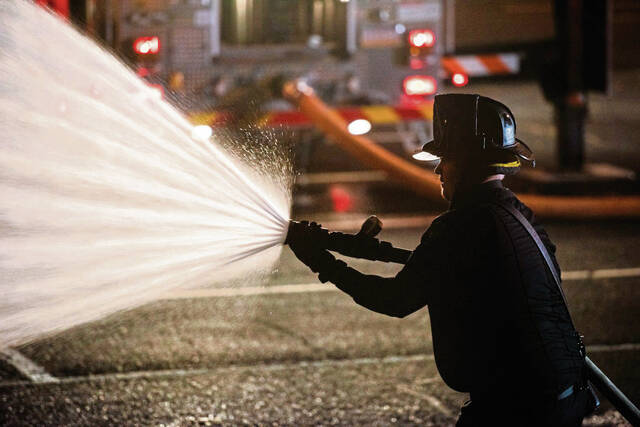Editorial: Regionalization could rescue volunteer fire departments
Pennsylvania has 67 counties. Those counties contain 2,560 municipalities of various sizes, each with its own internal organizations.
There are 2,400 fire departments, according to the Office of the State Fire Commissioner. More than 2,300 of those are strictly volunteer. Another 72 are a mix of volunteers with at least some paid firefighters. There are just 22 completely professional fire departments in the Keystone State.
The volunteer companies may receive some financial support from the municipalities they serve, but how much is never a guarantee. Most of the fire protection in Pennsylvania is provided by people with day jobs — people who also sell raffle tickets and fry fish and stand at intersections with an empty boot begging.
That’s how they raise the money that lets them buy the gas to drive to a burning building and risk their lives for free.
In the past 24 years, the number of firefighters has dropped by about 37%. Over 50 years, the drop is closer to 90%. There are now just 38,000 volunteers spread across those companies. That’s approximately 16 firefighters apiece.
Imagine your house is on fire. The company closest to you responds. Their 16 firefighters aren’t all available. A couple are out of town. A few are at work and don’t have the kind of job that lets them leave. Maybe half are free to respond.
But firefighters are used to cooperating. Multiple companies often respond to the same event. Perhaps it’s a need for more manpower. It might be about equipment the situation demands but the local company doesn’t have. Whatever the reason, firefighters are always more than happy to have another person on the job and another truck at the scene.
Some of the companies aren’t waiting for mutual aid calls to bring them together. They are joining forces and consolidating to get the everyday jobs done.
Harmar and Springdale came together to become Allegheny Valley Volunteer Fire Company in 2012, adding Cheswick to the mix 10 years later. In Tarentum, a study of Eureka Fire-Rescue, Highland Hose and Summit Hose will look at expenses versus needs and the possibility of moving toward regionalization. New Stanton, Youngwood and Hempfield could be looking at a similar move.
“From someone who has four decades in, I don’t see a lot of options without some type of partnership,” Eureka Chief Brad James said. “Whether it’s a merger or fire protection district, the semantics don’t matter. Consolidation is the only way to survive.”
Regionalization is how some areas are providing police protection. It’s how many of today’s school districts were born out of smaller districts decades ago. It makes sense to share resources and maximize assets — particularly when it is driven by the companies’ internal realizations of the challenges of standing alone.
It is unsurprising that fire companies are looking at the reality and trying to find the best solution. They are experts at evaluating a situation, prioritizing the problems and spotting the best way to deploy the personnel and equipment at hand — all while everything is burning down around them.
What they need is to have more recognition, appreciation and support of the vital work they do from government — both local and state.
Remove the ads from your TribLIVE reading experience but still support the journalists who create the content with TribLIVE Ad-Free.

